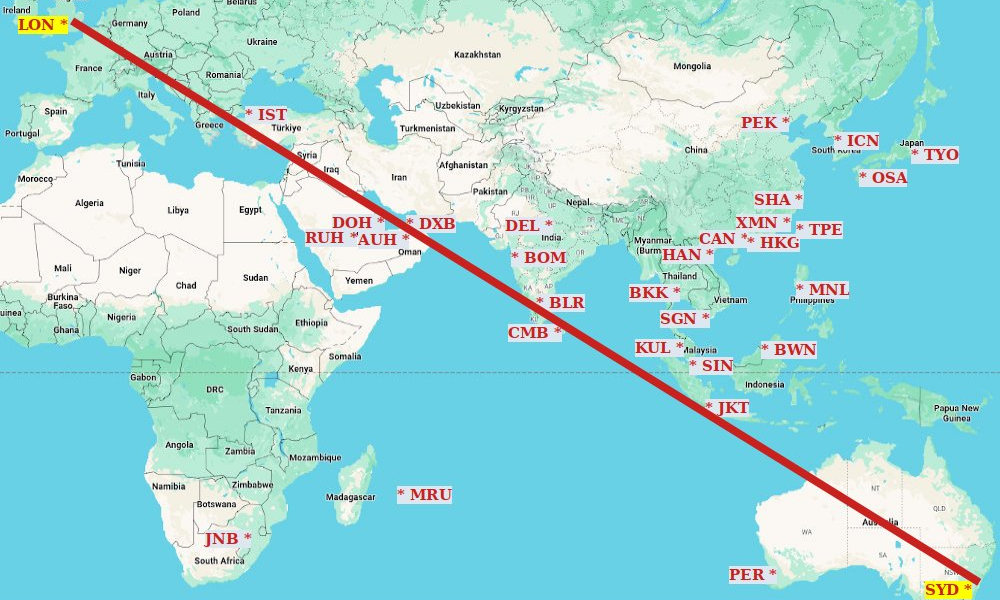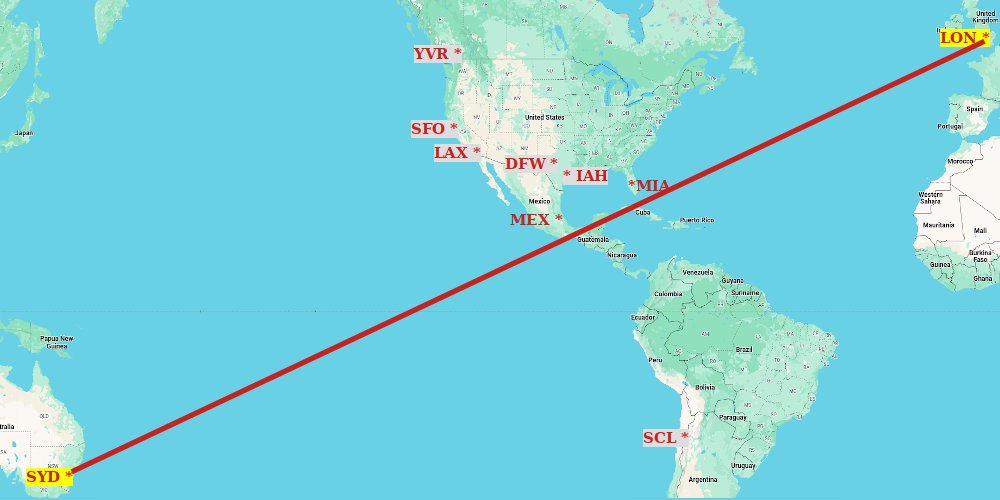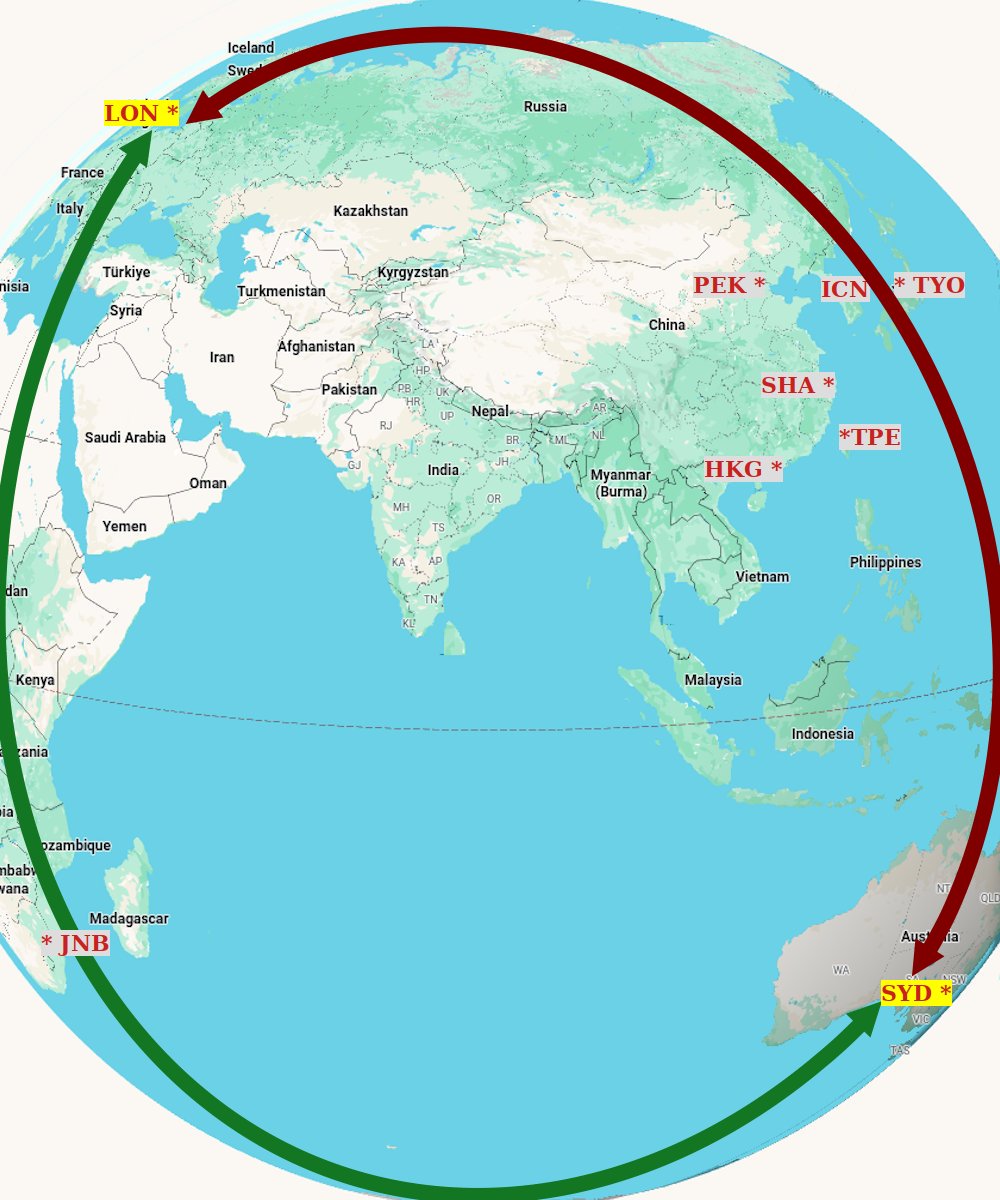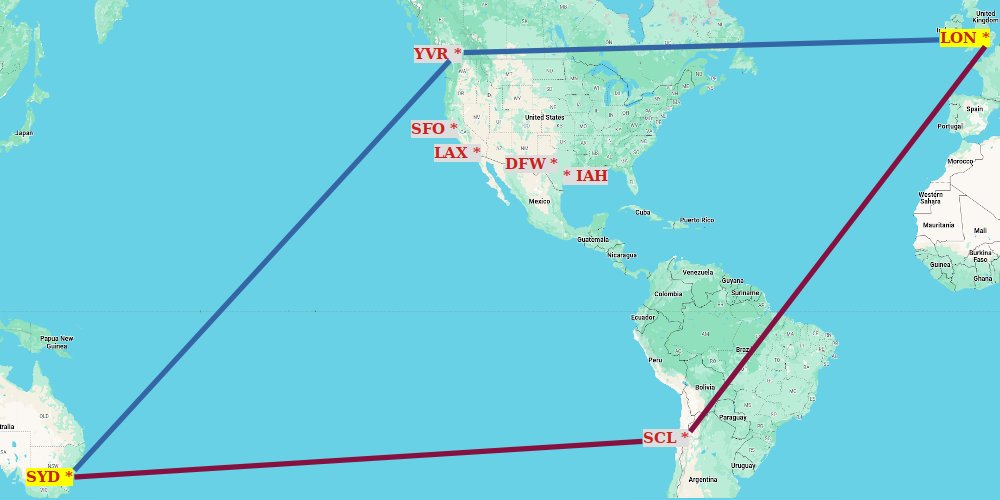Background
As Sydney International Airport (SYD) is the busiest airport in Australia and London Heathrow (LHR) is the busiest airport in Europe, SYD-LHR is the typical example of travel between Australia and Western Europe. Flights among other Australian cities and other Western European cities may involve slight variations in flights durations and prices, but the main routing options and operating airlines remain more or less the same.
Since there are ~1200 international airports worldwide and ~100 global airlines, it is estimated that there are 6,000,000,000 ways (routes) for traveling between Sydney and London! Fortunately, most routes are not offered by any airline; and one needs to book each segment individually--as a separate booking--which tends to be very expensive. Some Round The World (RTW) tickets may enable such complex routings, but are subject to many restrictions.
Airlines publish 100+ million fares, globally, with more than 2000 bookable routes between Sydney and London!
The Puzzle
Travel agents search and book flights using a database know as Global Distribution System (GDS) which stores information about every seat in every commercial flights in the world for the coming 360 days; that is 5+ billion seats at any moment. The GDS proposes possible travel routes in a maximum of 20 pages, and two to 12 routes per page. Research, worldwide, found that most travel agents usually select flights from the first page and seldom exceed the third page.
Whereas the GDS limits options to less than 10% of all possible flights/routes, the average travel agent further reduces the options to less than 1% of all possibilities. There are good reasons why the GDS places certain flights in the first page, and these may be indeed the ideal flights for many passengers. Yet, some passengers are denied the opportunity to $ave, by exploring the less-common routes.
At Bowing Travel, we do not rely on the GDS for flights selection. We have deeper knowledge about the airlines: their operations, published and unpublished routes and fares, pricing and availability. We are able to explore much wider pool of routing and airlines options. We offer our clients unique flights that cannot be found anywhere, even at the airlines' websites! Other travel agent may not even know that such routes exist.
An open-minded traveler may be attracted to such uncommon flights and $ave.
For International travel between Australia and Europe (SYD-LHR as example) your options in routing and airlines depend on your belief about the shape of the Earth!
Most passengers are still "Flat Earthers". 😄 😂 😇
Flat Earth Routing (EH)
If you believed that the Earth was flat 😂 then the shortest route between Sydney (SYD) and London (LON) is the straight line, shown in the map below. This is 17,000 Km (9200 nautical miles) with an average flight durations 22 hours outbound and 21 hours inbound.

Currently, no airliner has large enough fuel tanks to fly this whole distance non-stop. Airbus A380, A350-900 and A330-800 have flying ranges of ~15,000 Km, while A350-1000 has 16,000 Km range. Boeing 787-9 Dreamliner, 747-8, and 777X-8 have flying ranges of 14,000 Km, 15,000 Km, and 16,000 Km, respectively. Increasing flight range, by increasing fuel tank capacity, comes at the expenses of reduced number of passenger seats, higher ticket price, and may render the operation commercially uncompetitive. Qantas operates 17-hrs non-stop flights between Perth and London, and is planning 20-hrs non-stop flights between Sydney and London by 2026, using A350-900ULR. The ultra-long-haul flights may raise various health concerns, including severe Jet Lag, especially in the Economy Cabin.
Hence, it is almost unavoidable to split the journey and stop (for refuel or change flight) somewhere at a connection point along this route. The map above shows a number of possible connection points. The further the connection deviates from the straight line, the longer the total travel distance and time. Further, each landing and takeoff at a connection adds to total travel time. While 22-hours between SYD and LON is ideal, travel durations (including layovers) of 25-30 hours are common.
Cylindrical Earth Routing (AP)
If you believed, like Christopher Columbus, that the Earth was cylindrical 😄 then it is possible to travel from Sydney to London by crossing the Pacific and Atlantic oceans, with the shortest distance being along the straight line shown in the map below. This is whooping 22,000 Km distance, which is unlikely to be covered by a non-stop flight any time soon. A connection stop along this route is essential.

The ideal connection point needs to be as close as possible to the straight line, with Havana, Miami, or Mexico City as good candidates, but are unavailable from Australia. If connecting via Houston (IAH), the average SYD-LON flying time is 25-hrs outbound and 27-hrs inbound. When layover time is added, travel along this AP-route can easily exceed 30-hrs.
While this route seems exhausting, it has the advantage that many airlines operate trans-atlantic flights (between USA and Europe,) prices are very competitive, and may yield significant $avings.
Spherical Earth Routing (TS, AF)
The Earth is actually almost spherical in shape, i.e. distances between longitude lines near the Poles are shorter than distances between same longitude lines at the Equator. The Mercator Projection, in which Earth is drown as a flat surface, tends to distort geometry. It shows Canada, Europe, Russia and Australia larger than they really are, while showing Africa, India, and Indonesia smaller than they really are. The distance between Japan and UK on the real surface of the Earth is much shorter than it appears on a flat map. This fact enables some flight routes that may not make sense on a flat map but are great on a spherical Earth, as shown in the visual:

- From Australia, head North, along almost constant longitude until reaching the North Pole, then drop on Europe via Norway! Actually, it is not necessary to go all the way to the North Pole, and it is possible to approach Europe via Russia (Trans-Siberia). The connection hub can be Tokyo (TYO) or Seoul (ICN). Average flying duration via TYO is 24.5-hrs outbound and 23.5-hrs Inbound, whereas via ICN it is 25-hrs outbound and 22-hrs inbound. Including layover time, travel duration between SYD and LON can be ~30-hrs each way.
We can also exploit sphericity of the Earth to cross the Pacific and Atlantic oceans along high latitudes, where distances are much shorter than they appear on a flat maps. Two such routes are depicted below:
- From Australia, head East, along almost constant latitude, reaching Santiago (SCL), then head North East and enter Europe via Spain. Average flying duration SYD-LON via SCL is 27-hrs outbound and 29-hrs inbound. This route is best for passengers who would like to have a stopover in South America.
- From Australia, head North East to Vancouver (YVR), then East along almost constant latitude to the UK. Average flying duration SYD-LON via YVR is 23.5-hrs outbound and 25.5-hrs inbound, which is even shorter than via Los Angeles!

Along each route, there can be several connection hubs and operating airlines; thus, offering the astute passenger great number of travel options. Routes explored here are those involving non-stop or one-stop flights. If we extend the options to flights involving two or more stops, sky is the limit!
